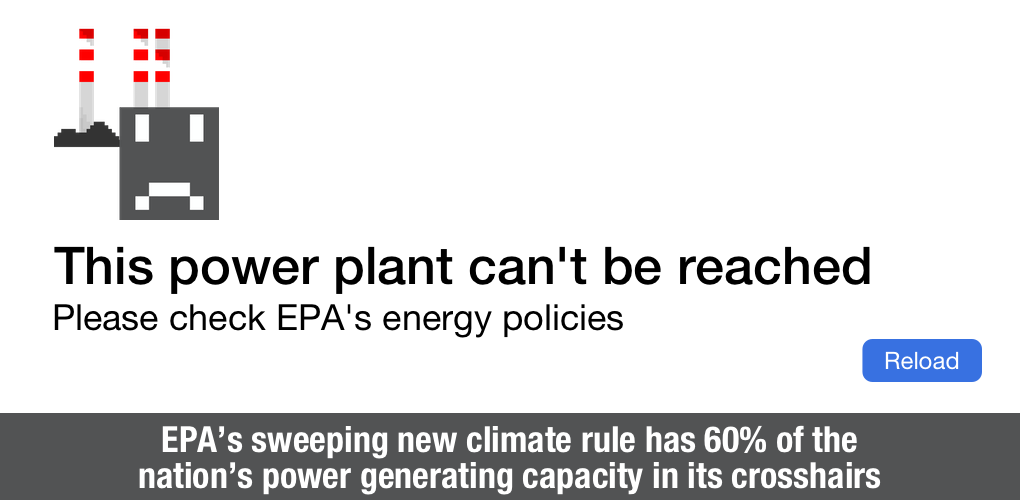
A Plan to Break the Grid
The U.S. Environmental Protection Agency (EPA) rolled out its sweeping new climate rule last week. In the plan’s crosshairs is the generating capacity that meets 60% of the nation’s power. Should the EPA get its way, today’s coal and gas fleets will be largely disassembled nearly overnight, posing a remarkable threat to a grid already in crisis.
While the EPA has tried to cast the plan as full of flexibility and long lead times for utilities, it will force plant owners to make decisions almost immediately about the future of their plants and the adoption of technologies that – despite EPA’s claims otherwise – are nowhere near ready for commercial, cost-effective deployment.
EPA’s mandated use of carbon capture and storage (CCS) is case in point. As important as CCS is – and will be – to global climate action, mandating its use at the nation’s coal plants by 2030 and claiming, as Section 111 of the Clean Air Act requires, that it’s “adequately demonstrated” is laughable. There is one coal plant in the world capturing carbon at the level EPA requires and it’s not even in the U.S.
Based on EPA’s proposed timeline, plant owners would need to install carbon capture at power plants, build required infrastructure – such as pipelines and injection wells – and permit them all in just five years. Not only does the infrastructure to transport CO2 not exist, storage options are few and far between. EPA itself admits 19 states have no potential for storage at all.
Even if a suitable storage location is accessible, the challenges hardly end there. Consider the mess of obtaining a Class VI underground injection control permit, as required under the Safe Drinking Water Act. Through January of this year, EPA has issued just two Class VI permits that made it to the injection phase. Both took six years to process.
So much remains to be solved on the CCS puzzle. Project developers aren’t even sure what types of pipelines to use for projects because the Pipeline and Hazardous Materials Safety Administration is still researching what types of materials and designs would best work for CO2 transport.
As Jennifer Wilcox, the principal deputy assistant secretary at the Department of Energy’s fossil energy office told Politico, many people have “misinterpreted” the data on how ready CCS is. People have drawn sweeping conclusions about its readiness at-scale based on its limited use on just one unit at a single site. DOE, for its part, is still funding demonstration projects.
Forcing Closures in a Reliability Crisis
EPA knows CCS isn’t adequately demonstrated and that’s the point. This newly proposed plan is about closing plants. It’s one piece – the icing on the cake – of EPA’s six-pronged effort to drive coal capacity off the grid.
Nearly a year and a half ago, EPA administrator Regan explicitly stated that EPA’s forthcoming power plant strategy would be designed to give plant owners certainty about the full package of regulatory pressures their plants would face.
“By presenting all of those rules at the same time to the industry,” Regan said, “the industry gets a chance to take a look at this suite of rules all at once and say, ‘Is it worth doubling down in investments in this current facility? Or should we look at that cost and say now it’s time to pivot.”
And as promised, EPA’s suite of rulemakings will accelerate plant closures—grid operators are already warning as much. That’s an extraordinary problem for a grid already facing alarming resource adequacy challenges as baseload capacity is pushed off the grid far faster than reliable replacements, and their enabling infrastructure, come online. What EPA is doing is precisely the opposite of what the nation’s grid reliability experts tell us should be happening.
Just this month, the Federal Energy Regulatory Commission (FERC) testified to the Senate Energy and Natural Resources Committee expressing grave concern about the “reliability crisis” and the challenges posed by the loss of dispatchable generation, particularly the coal fleet, as electricity demand begins a steep ascent from electrification. Even FERC Chairman Willie Philips, handpicked by the Biden administration, said, “I am extremely concerned about the pace of retirements we are seeing of generators which are needed for reliability on our system.”
If he was extremely concerned two weeks ago, you can pretty well imagine what he and the other commissioners are thinking now.
The North American Electric Reliability Corporation (NERC) has also warned again and again about eroding reliability and begged for caution in managing the energy transition. Just yesterday, it offered its summer reliability assessment finding that two-thirds of the nation is now at elevated risk of blackouts should extended and widespread heatwaves hit this summer. NERC’s assessment even went so far as to point to the EPA’s Good Neighbor rule, and how it’s likely to curtail coal generation in 23 states, as an important dynamic driving resource adequacy concerns in the months ahead.
“The system is closer to the edge,” said John Moura, NERC director of reliability assessment and performance analysis. He added, “We certainly don’t want to see many [fossil units] coming off at once. The systems simply cannot be changed overnight.”
EPA, apparently, did not get the memo.
In response to the EPA onslaught, National Mining Association president and CEO, Rich Nolan, observed, “Each one of the rules coming from the Biden administration’s EPA is designed to make it impossible for states and utilities to make decisions based on the merits of what keeps the lights on and electricity inflation low, forcing them to make decisions solely based on the EPA’s desire to end coal powered generation in the United States.” He rightfully concluded, “EPA’s indifference to the repercussions of its decisions on our ability to provide reliable, affordable electricity to Americans is simply reckless.”
- On May 18, 2023
